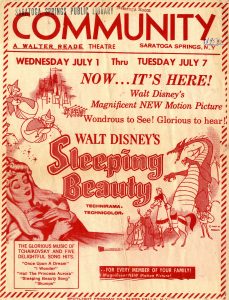
Original Movie Poster, 1959
There is something about going to the movies that creates memories that last. I will probably always remember that I saw “Gravity” in 3D the first night the new Bow Tie movie theater opened to the public. It was the first time that movies were shown in a commercial movie theater in downtown Saratoga Springs since the Community Theater closed in 1980.
Tom Roohan remembers seeing a showing of “Gone with the Wind” at the Community Theatre, 519 Broadway, which has been the home of his realty office since 2002. His cousin Stephen Towne, who also works in the office, remembers seeing “South Pacific” with his grandparents at that theater. And they both remember seeing “They Shoot Horses Don’t They,” a movie that they both recall being “terribly depressing.” According to Tom, it is not unusual for someone to stop in the office and share memories of movies that they saw at the theater.
In 1890, Charles Davidson, a Walworth descendent, inherited the vacant property at 519 Broadway. Three years later he sold the property to the Saratoga Club, an organization of prominent Saratoga men. The Saratoga Club constructed a three-story building to serve as their home. Despite a nearly $20,000 extensive remodel of the interior of the building in 1930 to accommodate a change in policy to include women’s activities, the Saratoga Club voluntarily dissolved three years later and sold the building to Benjamin Strauss.
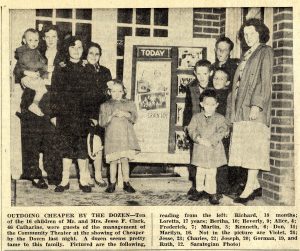 “The Saratogian” article dated January 5, 1937 reported that Walter A. Reade, a movie mogul who owned a chain of movie theaters in New York and New Jersey, wanted to open a theater in Saratoga Springs. According to the article, Reade petitioned the City Council to rezone a lot on Broadway south of Convention Hall and the Masonic Temple to allow a motion picture theater to be built.
“The Saratogian” article dated January 5, 1937 reported that Walter A. Reade, a movie mogul who owned a chain of movie theaters in New York and New Jersey, wanted to open a theater in Saratoga Springs. According to the article, Reade petitioned the City Council to rezone a lot on Broadway south of Convention Hall and the Masonic Temple to allow a motion picture theater to be built.
At the City Council meeting there was opposition to the proposal and a heated exchange between Walter Reade and Mayor Addison Mallory took place. There was yelling, name calling, and people nearly came to blows as “Mallory half rose to his feet as he shouted, and his right arm swung back behind him.” Mayor Mallory was discouraged from swinging by the City Attorney. Just before Walter Reade was to be escorted out by a police officer, he shouted “You don’t need to put me out, I’ll go. I’ll go, but I’ll be back. I’ll be doing business around here when you’re looking for a job.” Less than a minute later, the Council voted 4 to 1 to reject Reade’s petition for rezoning. However, the Council’s action was anticlimactic as Reade had announced earlier in the evening that he had purchased the vacant Saratoga Club and would build a theater there regardless of the action of the Council.
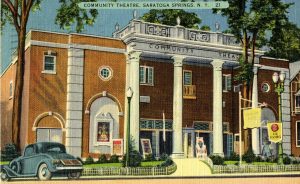
Colorized Depiction of the Theatre, 1941
However, the issue was not over because Dr. Moriarta, who lived and worked next door at 511 Broadway, commenced litigation to stop the construction of the theater. On January 18, 1937 the City Council approved the rezoning of the Saratoga Club. Mayor Mallory concurred with the decision and indicated that his previous objection to the other proposed location was due to concerns about traffic.
Walter Reade hired New York City architect Thomas W. Lamb to design the Community Theatre. Lamb was recognized as one of the leading architects of movie theaters. In particular, he was associated with Fox Theatres, Loew’s Theatres, and Keith-Albee-Orpheum Corporation, a chain of vaudeville and film theaters. Lamb was instrumental in developing the design of large, lavishly decorated theaters, known as “movie palaces.”
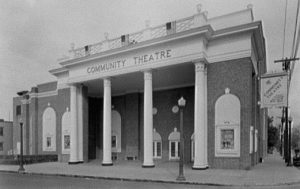
Similar Theatre Constructed by Reade in Hudson, NY
Lamb designed the 1,200 seat, fireproof and air-conditioned brick Colonial Revival movie theater with impressive white columns. Just eight months after the contentious City Council meeting, the theater opened to the public on July 28, 1938 with a showing of “Lost Horizon.” Walter Reade apparently was pleased with this design as he built others in Hudson, NY and Tom’s River, NJ.
The theater remained in the Walter Reade family until 1960 when it was sold to Community Theatres, Inc., an Albany Corporation owned by Sylvan Leff and Sidney Urbach. For sixteen years the theater was leased to others to operate. It faced the challenges of increased television viewership and competition from the multi-screen movie theaters at the mall in Wilton. At times the theater was met with criticism for showing X-rated films. On June 25, 1978 the last movie was shown at the theater, XX-rated “Vanessa.”
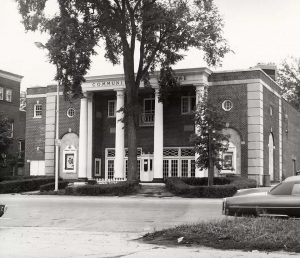
Original Community Theatre, Date Unknown
On June 30, 1978, Dr. James B. Dorsey, a Saratoga Springs physician, and his wife acquired the theater and planned to turn the building into a “high class discotheque.” However, those plans fell through when they were unable to acquire a liquor license due to the building’s proximity to a house of worship, Temple Sinai.
In 1980, Dr. Dorsey sold the property to Webster Nesbitt of Latham, NY. He converted the building into the Exchange Building to be used primarily as an investment exchange in diamonds, gold and silver, including rare coins, and gem stones. The Exchange did not fare well and closed three years later. The building remained vacant until Randy Martin and Nick Palmetto purchased the property in 1985.
“We purchased the property for investment purposes, but if we had not bought the property it would have been lost – water was running down the steps out the front door with two feet of water inside because of broken and leaking roof drains,” said Randy Martin when asked why he and Nick purchased the property. Randy enjoyed researching the building. He has found it to be fun to see how a building was designed and built and to think creatively about how to adapt it to new uses while maintaining its historic character. Converting the theater and the apartment above into offices had its challenges since the building had very few windows. He thinks that it was possible that bricks from the Saratoga Club were used to construct the Community Theater. When asked what movies he saw at the theater, he laughed and said, “I saw ‘Rebel Without a Cause.’ Had I known I was going to one day own the building I probably would have made a point to remember all the movies I saw.”
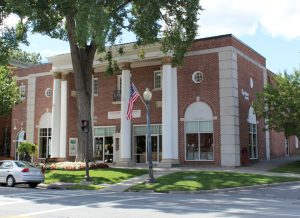
Community Theatre Today
Tom Roohan purchased the building in 2000. He made changes to accommodate his office, installing windows in the spaces where the movie posters once hung and he recently made changes to allow for the offices upstairs to have a better connection to Broadway. When asked about the building, he simply says, “I merely polished a diamond that I was given by Randy and Nick.”
Thankfully, the construction of our new movie theater was not contentious. I hope it stays for years to come and people enjoy seeing movies there and the memories made.
Founded in 1977, the Saratoga Springs Preservation Foundation is a private, not-for-profit organization that promotes preservation and enhancement of the architectural, cultural and landscaped heritage of Saratoga Springs. To learn more about the Foundation visit www.saratogapreservation.org.
